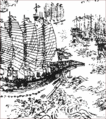Ayutthaya Kingdom
Kingdom of Ayutthaya อาณาจักรอยุธยา | |||||||||||||
|---|---|---|---|---|---|---|---|---|---|---|---|---|---|
| 1351–1767 | |||||||||||||
 Ayutthaya's zone of influence and neighbours, c. 1540 | |||||||||||||
| Status | Historical Kingdom | ||||||||||||
| Capital | Ayutthaya (1351-1463) Phitsanulok (1463-1488) | ||||||||||||
| Common languages | Ayutthayan Thai | ||||||||||||
| Religion | Majority: Theravada Buddhism Minority: Hinduism, Roman Catholic, Shia Islam, Sunni Islam | ||||||||||||
| Government | Feudal monarchy with Chatu Sdomph as executive body. | ||||||||||||
| King | |||||||||||||
• 1350–69 | Ramathibodi I (Uthong) | ||||||||||||
• 1590–1605 | Sanphet II (Naresuan) | ||||||||||||
• 1656–88 | Ramathibodi III (Narai) | ||||||||||||
• 1758–67 | Borommaracha III (Ekkathat) | ||||||||||||
| Legislature | The monarch | ||||||||||||
| Historical era | Middle Ages & Renaissance | ||||||||||||
• Uthong's ascends the throne in Ayutthaya | 1351 | ||||||||||||
• Personal union with Sukhothai Kingdom | 1438 | ||||||||||||
• Vassal of Taungoo Dynasty | 1564, 1569 | ||||||||||||
| 1583, 1584 | |||||||||||||
• Naresuan and Mingyi Swa's Elephant War | 1593 | ||||||||||||
• End of Sukhothai Dynasty | 1629 | ||||||||||||
| 1767 | |||||||||||||
| |||||||||||||
| Today part of | |||||||||||||
| History of Thailand |
|---|
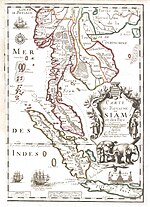 |
|
|
The Kingdom of Ayutthaya (/ɑːˈjuːtəjə/; Thai: อยุธยา, Thai pronunciation: [ʔajúttʰajaː]; also spelled Ayudhya or Ayodhaya) was a Siamese kingdom that existed from 1351 to 1767. Ayutthaya was friendly towards foreign traders, including the Chinese, Vietnamese, Indians, Japanese and Persians, and later the Portuguese, Spaniards, Dutch, English and French, permitting them to set up villages outside the walls of the capital, also called Ayutthaya.
In the sixteenth century, it was described by foreign traders as one of the biggest and wealthiest cities in the East. The court of King Narai (1656–88) had strong links with that of King Louis XIV of France, whose ambassadors compared the city in size and wealth to Paris.
By 1550, the kingdom's vassals included some city-states in the Malay Peninsula, Sukhothai, Lan Na and parts of Burma and Cambodia.[1] This part of the Kingdom's history is sometimes referred to as 'The Ayutthayan Empire.'
In foreign accounts, Ayutthaya was called Siam, but many sources say the people of Ayutthaya called themselves Tai, and their kingdom Krung Tai "The Tai country" (กรุงไท). It was also referred to as Iudea in a painting that was requested by the Dutch East India Company [note 1]
Historical overview
Origins

Blue Violet: Ayutthaya Kingdom
Dark Green: Lan Xang
Purple: Lan Na
Orange: Sukhothai Kingdom
Red: Khmer Empire
Yellow: Champa
Blue: Đại Việt


According to the most widely accepted version of its origin, the Thai state based at Ayutthaya in the valley of the Chao Phraya River rose from the earlier, nearby Lavo Kingdom (at that time, still under the control of the Khmer Empire) and Suvarnabhumi. One source says that in the mid-fourteenth century, due to the threat of an epidemic, King Uthong moved his court south into the rich floodplain of the Chao Phraya River onto an island surrounded by rivers.[2] The name of the city indicates the influence of Hinduism in the region. It is believed that this city is associated with the Thai national epic, the Ramakien, which is the Thai version of the Ramayana.
Conquests and expansion

Ayutthaya began its hegemony by conquering northern kingdoms and city-states like Sukhothai,[4]: 222 Kamphaeng Phet and Phitsanulok. Before the end of the fifteenth century, Ayutthaya launched attacks on Angkor, the classical great power of the region. Angkor's influence eventually faded from the Chao Phraya River Plain while Ayutthaya became a new great power.
The emerging Kingdom of Ayutthaya was also growing powerful. Relations between the Ayutthaya and Lan Na had worsened since the Ayutthayan support of Thau Choi's rebellion In 1451, Yuttitthira, a noble of the Kingdom of Sukhothai who had conflicts with Borommatrailokkanat of Ayutthaya, gave himself to Tilokaraj. Yuttitthira urged Borommatrailokkanat to invade Phitsanulok, igniting the Ayutthaya-Lan Na War over the Upper Chao Phraya valley (the Kingdom of Sukhothai). In 1460, the governor of Chaliang surrendered to Tilokaraj. Borommatrailokkanat then used a new strategy and concentrated on the wars with Lanna by moving the capital to Phitsanulok. Lan Na suffered setbacks and Tilokaraj eventually sued for peace in 1475.
However, the kingdom of Ayutthaya was not a unified state but rather a patchwork of self-governing principalities and tributary provinces owing allegiance to the king of Ayutthaya under The Circle of Power, or the mandala system, as some scholars suggested .[5] These principalities might be ruled by members of the royal family of Ayutthaya, or by local rulers who had their own independent armies, having a duty to assist the capital when war or invasion occurred. However, it was evident that from time to time local revolts, led by local princes or kings, took place. Ayutthaya had to suppress them.
Due to the lack of succession law and a strong concept of meritocracy, whenever the succession was in dispute, princely governors or powerful dignitaries claiming their merit gathered their forces and moved on the capital to press their claims, culminating in several bloody coups.[6]
Beginning in the fifteenth century, Ayutthaya showed an interest in the Malay Peninsula, but the great trading ports of the Malacca Sultanate contested its claims to sovereignty. Ayutthaya launched several abortive conquests against Malacca which was diplomatically and economically fortified by the military support of Ming China. In the early fifteenth century the Ming admiral Zheng He had established a base of operation in the port city, making it a strategic position the Chinese could not afford to lose to the Siamese. Under this protection, Malacca flourished, becoming one of Ayutthaya's great foes until the capture of Malacca by the Portuguese.[7]
First Burmese wars
Starting in the middle of the 16th century, the kingdom came under repeated attacks by the Taungoo Dynasty of Burma. The Burmese–Siamese War (1547–49) began with Burmese an invasion and a failed siege of Ayutthaya. A second siege (1563–64) led by King Bayinnaung forced King Maha Chakkraphat to surrender in 1564. The royal family was taken to Bago, Burma, with the king's second son Mahinthrathirat installed as the vassal king.[8][9] In 1568, Mahinthrathirat revolted when his father managed to return from Bago as a Buddhist monk. The ensuing third siege captured Ayutthaya in 1569 and Bayinnaung made Mahathammarachathirat his vassal king.[9]
After Bayinnaung's death in 1581, uparaja Naresuan proclaimed Ayutthaya's independence in 1584. The Thai fought off repeated Burmese invasions (1584–1593), capped by an elephant duel between King Naresuan and Burmese heir-apparent Mingyi Swa in 1593 during the fourth siege of Ayutthaya in which Naresuan famously slew Mingyi Swa [citation needed] (observed 18 January as Royal Thai Armed Forces day). The Burmese–Siamese War (1594–1605) was a Thai attack on Burma, resulting in the capture of the Tanintharyi Region as far as Mottama in 1595 and Lan Na in 1602. Naresuan even invaded mainland Burma as far as Taungoo in 1600, but was driven back.[citation needed]
After Naresuan's death in 1605, northern Tanintharyi and Lan Na returned to Burmese control in 1614.[10]
The Ayutthaya Kingdom's attempt to take over Lan Na and northern Tanintharyi in 1662–1664 failed.[11]
Foreign trade brought Ayutthaya not only luxury items but also new arms and weapons. In the mid-seventeenth century, during King Narai's reign, Ayutthaya became very prosperous.[12] In the eighteenth century, Ayutthaya gradually lost control over its provinces. Provincial governors exerted their power independently, and rebellions against the capital began.
Second Burmese wars
In the mid-eighteenth century, Ayutthaya again became ensnared in wars with the Burmese. The Burmese–Siamese War (1759–60) begun by the Konbaung Dynasty of Burma failed. The Burmese–Siamese War (1765–67) resulted in the sack of the city of Ayutthaya and the end of the kingdom by debellatio in April 1767.
Government
Kingship of Ayutthaya Kingdom

The kings of Ayutthaya were absolute monarchs with semi-religious status. Their authority derived from the ideologies of Hinduism and Buddhism as well as from natural leadership. The king of Sukhothai was the inspiration of Inscription 1 found in Sukhothai, which stated that King Ramkhamhaeng would hear the petition of any subject who rang the bell at the palace gate. The king was thus considered as a father by his people.
At Ayutthaya, however, the paternal aspects of kingship disappeared. The king was considered the chakkraphat (Sanskrit chakravartin) who through his adherence to the law made all the world revolve around him.[13] According to Hindu tradition, the king is the avatar of Vishnu, destroyer of demons, who was born to be the defender of the people. The Buddhist belief in the king is as righteous ruler (Sanskrit: dharmaraja), aiming at the well-being of the people and who strictly follows the teaching of Gautama Buddha.
The kings' official names were reflections of those religions: Hinduism and Buddhism. They were considered as the incarnation of various Hindu gods: Indra, Shiva or Vishnu (Rama). The coronation ceremony was directed by brahmins as the Hindu god Shiva was "lord of the universe". However, according to the codes, the king had the ultimate duty as protector of the people and the annihilator of evil.
According to Buddhism, the king was also believed to be a bodhisattva. One of the most important duties of the king was to build a temple or a Buddha statue as a symbol of prosperity and peace.[13]
For locals, another aspect of the kingship was also the analogy of "The Lord of the Land" or "He who Rules the Earth" (Phra Chao Phaendin). According to the court etiquette, a special language, Rachasap (Sanskrit: Rājāśabda, "Royal Language"), was used to communicate with or about royalty.[14][15] In Ayutthaya, the king was said to grant control over land to his subjects, from nobles to commoners, according to the Sakna or Sakdina system[16] codified by King Borommatrailokkanat (1448–88). The Sakdina system was similar to, but not the same as feudalism, under which the monarch does not own the land.[17] While there is no concrete evidence that this land management system constituted a formal palace economy, the French François-Timoléon de Choisy, who came to Ayutthaya in 1685, wrote, "the king has absolute power. He is truly the god of the Siamese: no-one dares to utter his name." Another 17th-century writer, the Dutchman Jan van Vliet, remarked that the King of Siam was "honoured and worshipped by his subjects second to god." Laws and orders were issued by the king. For sometimes the king himself was also the highest judge who judged and punished important criminals such as traitors or rebels.[18]
In addition to the Sakdina system, another of the numerous institutional innovations of Borommatrailokkanat was to adopt the position of uparaja, translated as "viceroy" or "prince", usually held by the king's senior son or full brother, in an attempt to regularise the succession to the throne—a particularly difficult feat for a polygamous dynasty. In practice, there was inherent conflict between king and uparaja and frequent disputed successions.[19] However, it is evident that the power of the Throne of Ayutthaya had its limit. The hegemony of the Ayutthaya king was always based on his charisma in terms of his age and supporters. Without supporters, bloody coups took place from time to time. The most powerful figures of the capital were always generals, or the Minister of Military Department, Kalahom. During the last century of Ayutthaya, the bloody fighting among princes and generals, aiming at the throne, plagued the court.
Social and political development
Social classes

The reforms of King Borommatrailokkanat (r. 1448–1488) placed the king of Ayutthaya at the centre of a highly stratified social and political hierarchy that extended throughout the realm. Despite a lack of evidence, it is believed that in the Ayutthaya Kingdom, the basic unit of social organisation was the village community composed of extended family households. Title to land resided with the headman, who held it in the name of the community, although peasant proprietors enjoyed the use of land as long as they cultivated it.[20] The lords gradually became courtiers (อำมาตย์) and tributary rulers of minor cities. The king ultimately came to be recognised as the earthly incarnation of Shiva or Vishnu and became the sacred object of politico-religious cult practices officiated over by royal court brahmans, part of the Buddhist court retinue. In the Buddhist context, the devaraja (divine king) was a bodhisattva. The belief in divine kingship prevailed into the eighteenth century, although by that time its religious implications had limited impact.
With ample reserves of land available for cultivation, the realm depended on the acquisition and control of adequate manpower for farm labour and defence. The dramatic rise of Ayutthaya had entailed constant warfare and, as none of the parties in the region possessed a technological advantage, the outcome of battles was usually determined by the size of the armies. After each victorious campaign, Ayutthaya carried away a number of conquered people to its own territory, where they were assimilated and added to the labour force.[20] Ramathibodi II (r.1491–1529) established a corvée system under which every freeman had to be registered as a phrai (servant) with the local lords, Chao Nai (เจ้านาย). When war broke out, male phrai were subject to impressment. Above the phrai was a nai (นาย), who was responsible for military service, corvée labour on public works, and on the land of the official to whom he was assigned. Phrai Suay (ไพร่ส่วย) met labour obligations by paying a tax. If he found the forced labour under his nai repugnant, he could sell himself as a that (ทาส, slave) to a more attractive nai or lord, who then paid a fee in compensation for the loss of corvée labour. As much as one-third of the manpower supply into the nineteenth century was composed of phrai.[20]

Wealth, status, and political influence were interrelated. The king allotted rice fields to court officials, provincial governors, military commanders, in payment for their services to the crown, according to the sakdi na system. The size of each official's allotment was determined by the number of commoners or phrai he could command to work it. The amount of manpower a particular headman, or official, could command determined his status relative to others in the hierarchy and his wealth. At the apex of the hierarchy, the king, who was symbolically the realm's largest landholder, theoretically commanded the services of the largest number of phrai, called phrai luang (royal servants), who paid taxes, served in the royal army, and worked on the crown lands.[20]
However, the recruitment of the armed forces depended on nai, or mun nai, literally meaning 'lord', officials who commanded their own phrai som, or subjects. These officials had to submit to the king's command when war broke out. Officials thus became the key figures to the kingdom's politics. At least two officials staged coups, taking the throne themselves while bloody struggles between the king and his officials, followed by purges of court officials, were always seen.[20]
King Trailok, in the early sixteenth century, established definite allotments of land and phrai for the royal officials at each rung in the hierarchy, thus determining the country's social structure until the introduction of salaries for government officials in the nineteenth century.[20]
Outside this system to some extent were the sangha (Buddhist monastic community), which all classes of men could join, and the Overseas Chinese. Wats became centres of Thai education and culture, while during this period the Chinese first began to settle in Thailand and soon began to establish control over the country's economic life.[20]
The Chinese were not obliged to register for corvée duty, so they were free to move about the kingdom at will and engage in commerce. By the sixteenth century, the Chinese controlled Ayutthaya's internal trade and had found important places in the civil and military service. Most of these men took Thai wives because few women left China to accompany the men.[20]
Uthong was responsible for the compilation of a Dharmaśāstra, a legal code based on Hindu sources and traditional Thai custom. The Dharmaśāstra remained a tool of Thai law until late in the 19th century. A bureaucracy based on a hierarchy of ranked and titled officials was introduced, and society was organised in a related manner. However, the caste system was not adopted.[21]
The sixteenth century witnessed the rise of Burma, which had overrun Chiang Mai and Laos and made war on the Thai. In 1569, Burmese forces, joined by Thai rebels, mostly royal family members of Thailand, captured the city of Ayutthaya and carried off the whole royal family to Burma. Dhammaraja (1569–90), a Thai governor who had aided the Burmese, was installed as vassal king at Ayutthaya. Thai independence was restored by his son, King Naresuan (1590–1605), who turned on the Burmese and by 1600 had driven them from the country.[22]
Determined to prevent another treason like his father's, Naresuan set about unifying the country's administration directly under the royal court at Ayutthaya. He ended the practice of nominating royal princes to govern Ayutthaya's provinces, assigning instead court officials who were expected to execute policies handed down by the king. Thereafter royal princes were confined to the capital. Their power struggles continued, but at court under the king's watchful eye.[23]
To ensure his control over the new class of governors, Naresuan decreed that all freemen subject to phrai service had become phrai luang, bound directly to the king, who distributed the use of their services to his officials. This measure gave the king a theoretical monopoly on all manpower, and the idea developed that since the king owned the services of all the people, he also possessed all the land. Ministerial offices and governorships—-and the sakdina that went with them—-were usually inherited positions dominated by a few families often connected to the king by marriage. Indeed, marriage was frequently used by Thai kings to cement alliances between themselves and powerful families, a custom prevailing through the nineteenth century. As a result of this policy, the king's wives usually numbered in the dozens.[23]

Even with Naresuan's reforms, the effectiveness of the royal government over the next 150 years was unstable. Royal power outside the crown lands-—although in theory absolute—was in practice limited by the looseness of the civil administration. The influence of central government and the king was not extensive beyond the capital. When war with the Burmese broke out in late eighteenth century, provinces easily abandoned the capital. As the enforcing troops were not easily rallied to defend the capital, the city of Ayutthaya could not stand against the Burmese aggressors.[23]
Military
Ayutthaya's military was the origin of the Royal Thai Army. The army was organised into a small standing army of a few thousand, which defended the capital and the palace, and a much larger conscript-based wartime army. Conscription was based on the Phrai system (including phrai luang and phrai som), which required local chiefs to supply their predetermined quota of men from their jurisdiction on the basis of population in times of war. This basic system of military organisation was largely unchanged down to the early Rattanakosin period.
The main weaponry of the infantry largely consisted of swords, spears and bow and arrows. The infantry units were supported by cavalry and elephantry corps.
Religion
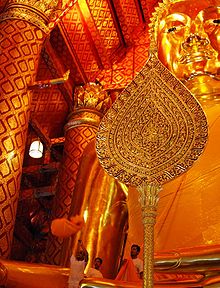
Ayutthaya's main religion was Theravada Buddhism. However, many of the elements of the political and social system were incorporated from Hindu scriptures and were conducted by Brahmin priests.[21] Many areas of the kingdom also practised Mahayana Buddhism, Islam[24] and, influenced by French Missionaries who arrived through China in the 17th century, some small areas converted to Roman Catholicism.[25] The influence of Mahayana and Tantric practices also entered Theravada Buddhism, producing a tradition called Tantric Theravada.
The natural world was also home to a number of spirits which are part of the Satsana Phi. Phi (Thai: ผี) are spirits of buildings or territories, natural places, or phenomena; they are also ancestral spirits that protect people, or can also include malevolent spirits. The phi which are guardian deities of places, or towns are celebrated at festivals with communal gatherings and offerings of food. The spirits run throughout Thai folklore.[26]
Phi were believed to influence natural phenomena including human illness and thus the baci became an important part of people identity and religious health over the millennia. Spirit houses were an important folk custom which were used to ensure balance with the natural and supernatural world. Astrology was also a vital part to understanding the natural and spiritual worlds and became an important cultural means to enforce social taboos and customs.
Arts and Cultures

The Royal Court of Ayutthaya was already performing Khôn and other classical dances which were almost identical to the Thai traditions which survive today. Historical evidence clearly establishes that the Thai art of stage plays must have already been perfected by the 17th Century. Louis XIV, the Sun King of France, had a formal diplomatic relation with Ayutthaya’s King Narai. In 1687, France sent the diplomat Simon de la Loubère to record all that he saw in the Siamese Kingdom and its traditions. In his famous account “Du Royaume de Siam”, La Loubère carefully observed the classic 17th-century theatre of Siam, including an epic battle scene from a Khon performance, and recorded what he saw in great details:
“The Siamese have three sorts of Stage Plays: That which they call Cone [Khôn] is a figure dance, to the sound of the violin and some other instruments. The dancers are masked and armed, and represent rather a combat than a dance. And though every one runs into high motions, and extravagant postures, they cease not continually to intermix some word. Most of their masks are hideous, and represent either monstrous Beasts, or kinds of Devils. The Show which they call Lacone is a poem intermix with Epic and Dramatic, which lasts three days, from eight in the morning till seven at night. They are histories in verse, serious, and sung by several actors always present, and which do only sing reciprocally …. The Rabam is a double dance of men and women, which is not martial, but gallant … they can perform it without much tying themselves, because their way of dancing is a simple march round, very slow, and without any high motion; but with a great many slow contortions of the body and arms.”[27]
Of the attires of Siamese Khôn dancers, La Loubère recorded that:
“[T]hose that dance in Rabam, and Cone, have gilded paper-bonnets, high and pointed, like the Mandarins caps of ceremony, but which hang down at the sides below their ears, which are adorned with counterfeit stones, and with two pendants of gilded wood.”[28]
La Loubère also observed the existence of Muay Thai and Muay Laos, noting that they looked similar (i.e. using both fists and elbows to fight) but the hand-wrapping techniques were different.[28]
Architecture
The Ayutthaya buddhist temple falls into one of two broad categories: the stupa-style solid temple and the Prang-style (Thai: ปรางค์). the Prangs can also be found in various forms in Sukhothai, Lopburi, Bangkok (Wat Arun). Sizes may vary, but usually the prangs measure between 15 and 40 meters in height, and resemble a towering corn-cob like structure.
Prangs essentially represent Mount Meru. In Thailand Buddha relics were often housed in a vault in these structures, reflecting the belief that the Lord Buddha is a most significant being in having attained enlightenment and having shows the path to enlightenment to others.[29]
Notable Ayutthaya architecture sites
| Name | Picture | Built | Sponsor(s) |
|---|---|---|---|
| Wat Chai Watthanaram | 
|
1630 | King Prasat Thong |
| Wat Mahathat | 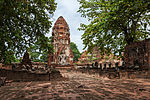
|
1374 | King Borommaracha I |
| Wat Phanan Choeng | 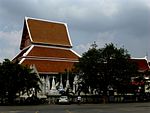
|
1324 | |
| Wat Phra Si Sanphet | 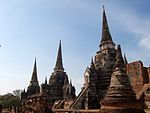
|
1350 | King Ramathibodi I |
| Wat Ratchaburana | 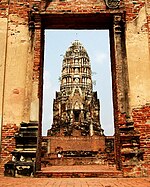
|
1424 | King Borommarachathirat II |
| Wat Lokaya Sutharam | 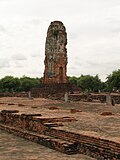
|
1452 | King Intharacha |
| Wat Phra Ram | 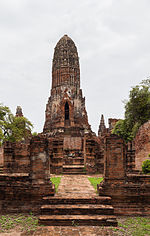
|
1369 | King Ramesuan |
| Wat Phutthaisawan | 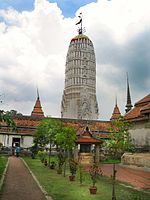
|
Before Ayutthaya was founded. | King Ramathibodi I |
| Wat Thammikarat | 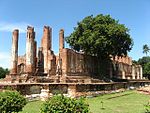
|
Before Ayutthaya was founded. | King of Lavo |
Literature
The representative work of Ayutthaya period is Lilit Ongkan Chaeng Nam (Thai: ลิลิตโองการแช่งน้ำ), an incantation in verse to be uttered before the gathering of courtiers, princes of foreign land, and repersentatives of vassal states at the taking of the oath of allegiance ceremony. It was a ritual to promote loyalty and close domestic and foreign alliances. Lilit Yuan Phai (Thai: ลิลิตยวนพ่าย), another work of the same purpose, is a narrative poem describing the war between King Borommatrailokkanat ( 1448-1488 ) and King Tilokaraj of Lanna. The third major word of the period is Mahajati Kam Luang (Thai: มหาชาติคำหลวง) written in the style of the Buddhist chant. In 1582 King Borommatrailokkanat authorized a group of scholars to write a poem based on the story of Vessantara, believed to be the geratest of Buddha's incarnations. Their joint effort was this great work and the precedence of reciting Maha, the Great Life, was then established.
The fourth piece is Lilit Phra Lo (Thai: ลิลิตพระลอ), the first poem to play on the emotions of the reader. Its author is unknown. This work is believed to have been written by the beginning of King's reign, certainly not later than 1656. The plot came from a folk tale in the north of Thailand. The tragic story has universal. The poem is an artistic and harmonious arrangement of words.
In Ayutthaya period folktale was also flourish, one of the famous folktales is the story of Khun Chang Khun Phaen (Thai: ขุนช้างขุนแผน), illustrates the classic love triangle, ending in high tragedy. Another popular character in Ayutthaya folktales is the trickster, the best known is Sri Thanonchai (Thai: ศรีธนญชัย), usually a heroic figure who teaches or learns moral lessons and is known for his charm, wit, and verbal dexterity.[30]
Economy

The Thais never lacked a rich food supply. Peasants planted rice for their own consumption and to pay taxes. Whatever remained was used to support religious institutions. From the thirteenth to the fifteenth centuries, however, a remarkable transformation took place in Thai rice cultivation. In the highlands, where rainfall had to be supplemented by a system of irrigation[note 2] that controlled the water level in flooded paddies, the Thais sowed the glutinous rice that is still the staple in the geographical regions of the North and Northeast. But in the floodplain of the Chao Phraya, farmers turned to a different variety of rice—-the so-called floating rice, a slender, non-glutinous grain introduced from Bengal—-that would grow fast enough to keep pace with the rise of the water level in the lowland fields.[31]
The new strain grew easily and abundantly, producing a surplus that could be sold cheaply abroad. Ayutthaya, situated at the southern extremity of the floodplain, thus became the hub of economic activity. Under royal patronage, corvée labour dug canals on which rice was brought from the fields to the king's ships for export to China. In the process, the Chao Phraya Delta—-mud flats between the sea and firm land hitherto considered unsuitable for habitation—-was reclaimed and placed under cultivation. Traditionally the king had a duty to perform a religious ceremony blessing the rice plantation.[31]
Although rice was abundant in Ayutthaya, rice export was banned from time to time when famine occurred because of natural calamity or war. Rice was usually bartered for luxury goods and armaments from westerners, but rice cultivation was mainly for the domestic market and rice export was evidently unreliable.
Ayutthaya as international trading port
Trade with Europeans was lively in the seventeenth century. In fact European merchants traded their goods, mainly modern arms such as rifles and cannons, with local products from the inland jungle such as sapan (lit. bridge) woods, deerskin and rice. Tomé Pires, a Portuguese voyager, mentioned in the sixteenth century that Ayutthaya, or Odia, was rich in good merchandise. Most of the foreign merchants coming to Ayutthaya were European and Chinese, and were taxed by the authorities. The kingdom had an abundance of rice, salt, dried fish, arrack and vegetables.[32]
Trade with foreigners, mainly the Dutch, reached its peak in the seventeenth century. Ayutthaya became a main destination for merchants from China and Japan. It was apparent that foreigners began taking part in the kingdom's politics. Ayutthayan kings employed foreign mercenaries who sometimes entered the wars with the kingdom's enemies. However, after the purge of the French in late seventeenth century, the major traders with Ayutthaya were the Chinese. The Dutch from the Dutch East Indies Company (Vereenigde Oost-Indische Compagnie or VOC), were still active. Ayutthaya's economy declined rapidly in the eighteenth century, until the Burmese invasion caused the total collapse of Ayutthaya's economy in 1788.[33]
Contacts with the West
In 1511, immediately after having conquered Malacca, the Portuguese sent a diplomatic mission headed by Duarte Fernandes to the court of King Ramathibodi II of Ayutthaya. Having established amicable relations between the Kingdom of Portugal and the Kingdom of Siam, they returned with a Siamese envoy with gifts and letters to the King of Portugal.[34] They were the first Europeans to visit the country. Five years after that initial contact, Ayutthaya and Portugal concluded a treaty granting the Portuguese permission to trade in the kingdom. A similar treaty in 1592 gave the Dutch a privileged position in the rice trade.
Foreigners were cordially welcomed at the court of Narai (1657–1688), a ruler with a cosmopolitan outlook who was nonetheless wary of outside influence. Important commercial ties were forged with Japan. Dutch and English trading companies were allowed to establish factories, and Thai diplomatic missions were sent to Paris and The Hague. By maintaining all these ties, the Thai court skilfully played off the Dutch against the English and the French, avoiding the excessive influence of a single power.[35]
In 1664, however, the Dutch used force to exact a treaty granting them extraterritorial rights as well as freer access to trade. At the urging of his foreign minister, the Greek adventurer Constantine Phaulkon, Narai turned to France for assistance. French engineers constructed fortifications for the Thais and built a new palace at Lopburi for Narai. In addition, French missionaries engaged in education and medicine and brought the first printing press into the country. Louis XIV's personal interest was aroused by reports from missionaries suggesting that Narai might be converted to Christianity.[36]
The French presence encouraged by Phaulkon, however, stirred the resentment and suspicions of the Thai nobles and Buddhist clergy. When word spread that Narai was dying, a general, Phetracha (reigned 1688–93) stage a coup d'état, the 1688 Siamese revolution, seized the throne, killed the designated heir, a Christian, and had Phaulkon put to death along with a number of missionaries and expelled the remaining foreigners. Some studies said that Ayutthaya began a period of alienation from western traders, while welcoming more Chinese merchants. But other recent studies argue that, due to wars and conflicts in Europe in the mid-eighteenth century, European merchants reduced their activities in the East. However, it was apparent that the Dutch East Indies Company or VOC was still doing business in Ayutthaya despite political difficulties.[36]
-
Dutch East India Company Merchant Ship.
-
Memorial plate in Lopburi showing King Narai with French ambassadors.
-
The French ambassador Chevalier de Chaumont presents a letter from Louis XIV to King Narai. Constance Phaulkon is seen kowtowing in the lower left corner of the print.
-
Siamese embassy to Louis XIV in 1686, by Nicolas Larmessin.
Contacts with the East Asia
Between 1405 and 1433, the Ming dynasty sponsored a series of seven naval expeditions. Emperor Yongle designed them to establish a Chinese presence, impose imperial control over trade, and impress foreign peoples in the Indian Ocean basin. He also might have wanted to extend the tributary system. It is believed that the Chinese fleet under Admiral Zheng He travelled up the Chao Phraya river to Ayutthaya on 3 occasions.
Meanwhile a Japanese colony was established in Ayutthaya. The colony was active in trade, particularly in the export of deer-hide and sappan wood to Japan in exchange for Japanese silver and Japanese handicrafts (swords, lacquered boxes, high-quality papers). From Ayutthaya, Japan was interested in purchasing Chinese silks, as well as deerskins and ray or shark skins (used to make a sort of shagreen for Japanese sword handles and scabbards).[37]
The Japanese quarters of Ayutthaya were home to about 1,500 Japanese inhabitants (some estimates run as high as 7,000). The community was called Ban Yipun in Thai, and was headed by a Japanese chief nominated by Thai authorities.[38] It seems to have been a combination of traders, Christian converts ("Kirishitan") who had fled their home country to various Southeast Asian countries following the persecutions of Toyotomi Hideyoshi and Tokugawa Ieyasu, and unemployed former samurai who had been on the losing side at the battle of Sekigahara.[38]
Padre António Francisco Cardim recounted having administered sacrament to around 400 Japanese Christians in 1627 in the Thai capital of Ayuthaya ("a 400 japoes christaos")[38] There were also Japanese communities in Ligor and Patani.[39]
-
Early 17th-century Chinese woodblock print, thought to represent Zheng He's ships.
-
A 1634 Japanese Red seal ship. Tokyo Naval Science Museum.
-
The Japanese quarter in Ayutthaya is indicated at the bottom center ("Japonois") of the map.
-
Portrait of Yamada Nagamasa c.1630.
The final phase


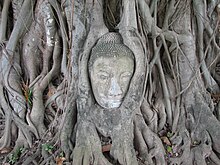
After a bloody period of dynastic struggle, Ayutthaya entered into what has been called the golden age, a relatively peaceful episode in the second quarter of the eighteenth century when art, literature, and learning flourished. There were foreign wars. Ayutthaya fought with the Nguyễn Lords (Vietnamese rulers of South Vietnam) for control of Cambodia starting around 1715. But a greater threat came from Burma, where the new Alaungpaya dynasty (Konbaung dynasty) had subdued the Shan states.[40]
The last fifty years of the kingdom witnessed a bloody struggle among the princes. The throne was their prime target. Purges of court officials and able generals followed. The last monarch, Ekathat, originally known as Prince Anurakmontree, forced the king, who was his younger brother, to step down and took the throne himself.[41]
According to a French source, Ayutthaya in the eighteenth century comprised these principal cities: Martaban, Ligor or Nakhon Sri Thammarat, Tenasserim, Junk Ceylon or Phuket Island, Singora or Songkhla. Her tributaries were Patani, Pahang, Perak, Kedah and Malacca.[42]
In 1765, a combined 40,000-strong force of Burmese armies invaded the territories of Ayutthaya from the north and west.[43] Major outlying towns quickly capitulated. The only notable example of successful resistance to these forces was found at the village of Bang Rajan. After a 14 months' siege, the city of Ayutthaya capitulated and was burned in April 1767.[44] Ayutthaya's art treasures, the libraries containing its literature, and the archives housing its historic records were almost totally destroyed,[44] and the Burmese brought the Ayutthaya Kingdom to ruin.[44]
The Burmese rule lasted a mere few months. The Burmese, who had also been fighting a simultaneous war with the Chinese since 1765, were forced to withdraw in early 1768 when the Chinese forces threatened their own capital.[45]
With most Burmese forces having withdrawn, the country was reduced to chaos. All that remained of the old capital were some ruins of the royal palace. Provinces proclaimed independence under generals, rogue monks, and members of the royal family.
One general, Phraya Taksin, former governor of Tak, began the reunification effort.[46][47] He gathered forces and began striking back at the Burmese. He finally established a capital at Thonburi, across the Chao Phraya from the present capital, Bangkok. Taak-Sin ascended the throne, becoming known as King Taak-Sin or Taksin.[46][47]
The ruins of the historic city of Ayutthaya and "associated historic towns" in the Ayutthaya historical park have been listed by the UNESCO as World Heritage Site.[48] The city of Ayutthaya was refounded near the old city, and is now capital of the Ayutthaya province.[49]
Rulers
List of notable foreigners in seventeenth century Ayutthaya
- Constantine Phaulkon, Greek Adventurer and First Councillor of King Narai
- François-Timoléon de Choisy
- Father Guy Tachard, French Jesuit Writer and Siamese Ambassador to France (1688)
- Louis Laneau, Apostolic Vicar of Siam
- Yamada Nagamasa, Japanese adventurer who became the ruler of the Nakhon Si Thammarat province
Image gallery
-
Detached Buddha head encased in fig tree roots
-
Seated Buddha, Ayutthaya
-
Seated Buddha, Ayutthaya
See also
Notes
- ^ Roberts, Edmund (1837). "XVIII —City of Bang-kok". Embassy to the Eastern courts of Cochin-China, Siam, and Muscat : in the U. S. sloop-of-war Peacock during the years 1832-3-4. Harper & brothers. p. image 288. OCLC 12212199.
The spot on which the present capital stands, and the country in its vicinity, on both banks of the river for a considerable distance, were formerly, before the removal of the court to its present situation called Bang-kok; but since that time, and for nearly sixty years past, it has been named Sia yuthia, (pronounced See-ah you-tè-ah, and by the natives, Krung, that is, the capital;) it is called by both names here, but never Bang-kok; and they always correct foreigners when the latter make this mistake. The villages which occupy the right hand of the river, opposite to the capital, pass under the general name of Bang-kok.
- ^
Luo, Wei; Hartmann, John; Li, Jinfang; Sysamouth, Vinya (December 2000). "GIS Mapping and Analysis of Tai Linguistic and Settlement Patterns in Southern China" (PDF). Geographic Information Sciences. 6 (2). DeKalb: Northern Illinois University: 129–136. Retrieved 28 May 2013.
Abstract. By integrating linguistic information and physical geographic features in a GIS environment, this paper maps the spatial variation of terms connected with wet-rice farming of Tai minority groups in southern China and shows that the primary candidate of origin for proto-Tai is in the region of Guangxi-Guizhou, not Yunnan or the middle Yangtze River region as others have proposed....
{{cite journal}}: Cite has empty unknown parameters:|laydate=,|laysource=, and|laysummary=(help)
References
- ^ Hooker, Virginia Matheson (2003). A Short History of Malaysia: Linking East and West. St Leonards, New South Wales, AU: Allen & Unwin. p. 72. ISBN 1-86448-955-3. Retrieved 5 July 2009.
- ^ "The Foundation of Ayuthia" (PDF). Journal of the Siam Society. JSS Vol. 1.0e. Siam Heritage Trust. 1904.
There is an old city ... called by the people Müang U Thong (the city of King U Thong) and there is a tradition that Thao U Thong reigned over this city until an epidemic broke out and the people died in great numbers. He then abandoned the city and turning to the East looked out for another place to establish the capital; but the epidemic did not abate. He then crossed the Suphan (Tachin) river to escape the ravages of the epidemic, and even at the present time near the Suphan river there is a place called "Tha Thao U Thong" 'i. e.' the crossing of King U Thong.
{{cite journal}}:|first=missing|last=(help) - ^ http://www.nationmultimedia.com/2006/09/06/headlines/headlines_30012911.php
- ^ Coedès, George (1968). Walter F. Vella (ed.). The Indianized States of Southeast Asia. trans.Susan Brown Cowing. University of Hawaii Press. ISBN 978-0-8248-0368-1.
- ^ Higham 1989, p. 355
- ^ "The Aytthaya Era, 1350–1767". U. S. Library of Congress. Retrieved 25 July 2009.
- ^ Jin, Shaoqing (2005). Office of the People's Goverernment of Fujian Province (ed.). Zheng He's voyages down the western seas. Fujian, China: China Intercontinental Press. p. 58. ISBN 9787508507088. Retrieved 2 August 2009.
- ^ Lt. Gen. Sir Arthur P. Phayre (1883). History of Burma (1967 ed.). London: Susil Gupta. p. 111.
- ^ a b GE Harvey (1925). History of Burma. London: Frank Cass & Co. Ltd. pp. 167–170.
- ^ Phayre, pp. 127–130
- ^ Phayre, p. 139
- ^ Wyatt 2003, pp. 90–121
- ^ a b "Introduction". South East Asia site. Northern Illinois University. Archived from the original on 31 May 2009. Retrieved 3 October 2009.
{{cite web}}: Unknown parameter|deadurl=ignored (|url-status=suggested) (help) - ^ "The National Language". Mahidol University. 1 November 2002. Archived from the original on 5 March 2010. Retrieved 17 October 2009.
{{cite web}}: Unknown parameter|deadurl=ignored (|url-status=suggested) (help) - ^ "Royal Words". Internet resource for the Thai language. thai-language.com. 9 October 2013. Retrieved 4 October 2013.
- ^ "Thailand". Brief Description of the Country and its National/State Government Structure. UN ESCAP. 12 February 2002. Archived from the original on 2 April 2012. Retrieved 2 April 2012.
The traditional government system and social structure in Siam during this period was known as the Sakdina system. All land was owned by the ruler who granted land to members of the royal family and the nobility according to their ranks in the traditional bureaucratic hierarchy.
{{cite web}}: Unknown parameter|deadurl=ignored (|url-status=suggested) (help) - ^ Giles Ji Ungpakorn (2 April 2012). "Class and politics in Thailand". Thailand's Crisis and the Fight for Democracy. Links International Journal of Socialist Renewal. Archived from the original on 2 April 2012. Retrieved 2 April 2012.
This was a system of direct control over humans, rather than the use of land ownership to control labour....
{{cite web}}: Unknown parameter|deadurl=ignored (|url-status=suggested) (help) - ^ Bavadam, Lyla (14 March 2006). "Magnificint Ruins". Frontline. 26 (6). Retrieved 17 October 2009.
- ^ "HM Second King Pinklao". Soravij. Retrieved 17 October 2009.
- ^ a b c d e f g h "Ayutthaya". Mahidol University. 1 November 2002. Archived from the original on 23 February 2010. Retrieved 1 November 2009.
{{cite web}}: Unknown parameter|deadurl=ignored (|url-status=suggested) (help) - ^ a b "Background Note: Thailand". U.S. Department of State. July 2009. Archived from the original on 4 November 2009. Retrieved 8 November 2009.
{{cite web}}: Unknown parameter|deadurl=ignored (|url-status=suggested) (help) - ^ Ross, Ph.D., Kelly L. (2008). "The Periphery of China – Korea, Vietnam, Thailand, Laos, Cambodia, Burma, Tibet, and Mongolia". Freisian School. Retrieved 8 November 2009.
- ^ a b c Ring, Trudy; Robert M. Salkin (1995). International Dictionary of Historic Places: Asia and Oceania. Vol. 5. Sharon La Boda. Chicago: Fitzroy Dearborn Publishers. p. 56. ISBN 1-884964-04-4. Retrieved 10 December 2009.
- ^ Sheik Ahmad, Omar Farouk. "Muslims in the Kingdom of Ayyuthaya" (PDF). UKM. Retrieved 24 May 2012.
- ^ Indobhasa, Sao (2009). "Buddhism in Ayutthaya (1350–1767)". Ceylon Journey. Archived from the original on 25 August 2009. Retrieved 22 December 2009.
{{cite web}}: Unknown parameter|deadurl=ignored (|url-status=suggested) (help) - ^ Tossa, Nattavong & MacDonald (2008), p. 75–89.
- ^ Simon La Loubère, The Kingdom of Siam (Oxford Univ Press, 1986) (1693), p. 49
- ^ a b La Loubère (1693), at 49
- ^ Guido Vanhaleweyk. "The difference between Khmer prangs and Thai (Ayutthaya) prangs". Ayutthaya2020.com. Retrieved 31 May 2017.
- ^ Arne Kislenko (2004) Culture and Customs of Thailand. Greenwood. ISBN 9780313321283, p. 46
- ^ a b "The Economy and Economic Changes". The Ayutthaya Administration. Department of Provincial Administration. Archived from the original on 20 November 2010. Retrieved 30 January 2010.
{{cite web}}: Unknown parameter|deadurl=ignored (|url-status=suggested) (help) - ^ Tome Pires. The Suma Oriental of Tome Pires. London, The Hakluyt Society,1944, p.107
- ^ Vandenberg, Tricky (March 2009). "The Dutch in Ayutthaya". History of Ayutthaya. Retrieved 1 January 2010.
- ^ Donald Frederick Lach, Edwin J. Van Kley, "Asia in the making of Europe", pp. 520–521, University of Chicago Press, 1994, ISBN 978-0-226-46731-3
- ^ "The Beginning of Relations with Buropean Nations and Japan (sic)". Thai Ministry of Foreign Affairs. 2006. Retrieved 11 February 2010.
- ^ a b Smithies, Michael (2002). Three military accounts of the 1688 "Revolution" in Siam. Bangkok: Orchid Press. pp. 12, 100, 183. ISBN 974-524-005-2.
- ^ Boxer, p.293
- ^ a b c Ishii Yoneo. "Siam and Japan in pre-modern times: a note on mutual images". In Denoon, p. 154.
- ^ Boxer, p.297
- ^ "Ayutthaya". Thailand by Train. 2010. Retrieved 6 June 2010.
- ^ Ruangsilp 2007, p. 203
- ^ Dictionaire geographique universel. Amsterdam & Utrecht: Chez Francois Halma, 1750. p.880.
- ^ Harvey, p. 250
- ^ a b c Ruangsilp 2007, p. 218
- ^ Harvey, p. 253
- ^ a b Syamananda 1990, p. 94
- ^ a b Wood 1924, pp. 254–264
- ^ "World Heritagae Site Ayutthaya". UNESCO. Archived from the original on 10 April 2010. Retrieved 3 April 2010.
{{cite web}}: Unknown parameter|deadurl=ignored (|url-status=suggested) (help) - ^ พระราชกฤษฎีกาเปลี่ยนชื่ออำเภอกรุงเก่า พ.ศ. ๒๕๐๐ (PDF). Royal Gazette (in Thai). 74 (25 ก): 546. 5 March 1957.
Citations
- Original text adapted from the Library of Congress Country Study of Thailand
- Higham, Charles (1989). The Archaeology of Mainland Southeast Asia. Cambridge, England: Cambridge University Press. ISBN 0-521-27525-3. Retrieved 6 September 2009.
{{cite book}}: Invalid|ref=harv(help) - Marcinkowski, M. Ismail (2005). From Isfahan to Ayutthaya: Contacts between Iran and Siam in the 17th Century. Singapore: Pustaka Nasional. ISBN 9971-77-491-7. Retrieved 8 August 2009.
- Ruangsilp, Bhawan (2007). Dutch East India Company merchants at the court of Ayutthaya: Dutch Perceptions of the Thai Kingdom c. 1604–1765. Leiden, Netherlands: Koninklijke Brill NV. ISBN 0-300-08475-7. Retrieved 20 November 2009.
{{cite book}}: Invalid|ref=harv(help) - Syamananda, Rong (1990). A History of Thailand. Chulalongkorn University. ISBN 974-07-6413-4.
{{cite book}}: Invalid|ref=harv(help) - Wood, W.A.R (1924). A History of Siam. London: Fisher Unwin Ltd.
{{cite book}}: Invalid|ref=harv(help) - Wyatt, David K. (2003). Thailand: A Short History. New Haven, Connecticut: Yale University Press. ISBN 0-300-08475-7.
{{cite book}}: Invalid|ref=harv(help)
Further reading
- Bhawan Ruangsilp (2007). Dutch East India Company Merchants at the Court of Ayutthaya: Dutch Perceptions of the Thai Kingdom, Ca. 1604-1765. BRILL. ISBN 90-04-15600-3.
- Smithies, Michael. A Siamese Embassy Lost in Africa 1686: The Odyssey of Ok-Khun Chamman. Chiang Mai: Silkworm Books, 1999.
Dissertations retrieved from ProQuest-Dissertations and Theses on Aug.16,2006
Subject: Art History
- Listopad, John A. "The art and architecture of the reign of Somdet Phra Narai." Diss. U of Michigan, 1995.
Subject: Buddhist literature
- Chrystall, Beatrice. "Connections without limit: The refiguring of the Buddha in the Jinamahanidana." Diss. Harvard U, 2004.
Subject: History
- Smith, George V. "The Dutch East India Company in the Kingdom of Ayutthaya, 1604–1694." Diss. Northern Illinois U, 1974.
Subject: Buddhist literature
- Chrystall, Beatrice. "Connections without limit: The refiguring of the Buddha in the Jinamahanidana." Diss. Harvard U, 2004.
Subject:Urban planning
- Peerapun, Wannasilpa. "The economic impact of historic sites on the economy of Ayutthaya, Thailand." Diss. U of Akron, 1991.
Phongsawadan Krung Si Ayutthaya
There are 18 versions of Royal Chronicles of Ayutthaya (Phongsawadan Krung Si Ayutthaya) known to scholars.(According to Wyatt, David K. (1999). Chronicle of the Kingdom of Ayutthaya. Tokyo: The Center for East Asian Cultural Studies for UNESCO, The Toyo Bunko. pp. Introduction, 14. ISBN 978-4-89656-613-0.)
- Fifteenth-Century Fragment – Michael Vickery version(in English and Thai) and Ubonsi Atthaphan version in pp.215-231 (in Thai)
- Van Vliet Chronicle (1640) – Translated and compiled by the Dutch merchant. The original Thai manuscripts disappeared.
- The Luang Prasoet Version (1680) – Ayutthaha History (in Thai)
- CS 1136 Version (1774)
- The Nai (Nok) Kaeo Version (1782) - in pp.232-244 (in Thai)
- CS 1145 Version (1783)
- [ Sanggitiyavamsa] – Pali chronicle compiled by Phra Phonnarat, generally discussing Buddhism History of Thailand.
- CS 1157 Version of Phan Chanthanumat (1795)
- Thonburi Chronicle (1795)
- Somdet Phra Phonnarat Version (1795) – Thought to be identical to Bradley Version below.
- Culayuddhakaravamsa Vol.2 – Pali chronicle. - includes other three versions of the chronicle.
- Phra Chakraphatdiphong (Chat) Version (1808) (in Thai)
- Brith Museum Version (1807)
- Wat Ban Thalu Version (1812)
- ''Culayuddhakaravamsa Sermon (1820) . - includes other three versions of the chronicle.
- Bradley or Two-Volume Version (1864) – formerly called Krom Phra Paramanuchit Chinorot Version. [ Vol.1] [ Vol.2] [ Vol.3] or Vol.1 [ Vol.2]
- Pramanuchit's Abridged Version (1850) (in English)
- Royal Autograph Version (1855) - Vol. 1, Vol. 2
Some of these are available in Cushman, Richard D. (2000). The Royal Chronicles of Ayutthaya: A Synoptic Translation, edited by David K. Wyatt. Bangkok: The Siam Society.
Burmese account
These are Burmese historical accounts of Ayutthaya.
- Kham Hai Kan Chao Krung Kao (Lit. Testimony of inhabitants of Old Capital (i.e. Ayutthaya))
- Kham Hai Kan Khun Luang Ha Wat (Lit. Testimony of the "King who Seeks a Temple" (nickname of King Uthumphon)) - An English translation.
- Palm Leaf Manuscripts No.11997 of the Universities Central Library Collection or Yodaya Yazawin – Available in English in Tun Aung Chain tr. (2005) Chronicle of Ayutthaya, Yangon: Myanmar Historical Commission
Western account
- Second Voyage du Pere Tachard et des Jesuites envoyes par le Roi au Royaume de Siam. Paris: Horthemels, 1689.
External links
- Online Collection: Southeast Asia Visions Collection by Cornell University Library
- "History of Aythhaya – Your resources on old Siam"
- ayutthaya
- ayutthaya
- Ayutthaya Kingdom
- History of Thailand
- Tai history
- Former countries in Thai history
- Former countries in Southeast Asia
- Indianized kingdoms
- 14th century in Siam
- 15th century in Siam
- 16th century in Siam
- 17th century in Siam
- 18th century in Siam
- 1767 in Siam
- 1351 establishments in Asia
- 1767 disestablishments
- 1760s disestablishments in Asia
- 14th-century establishments in Siam
- 1760s disestablishments in Siam
- Former monarchies of Southeast Asia







